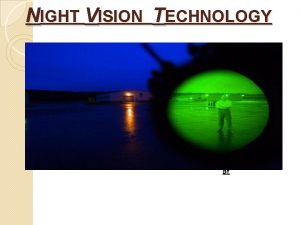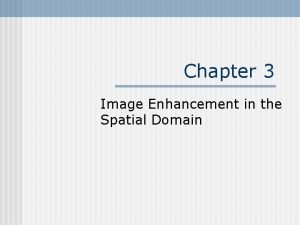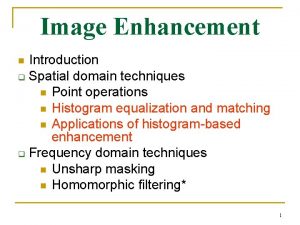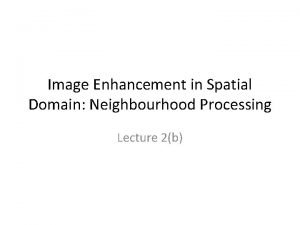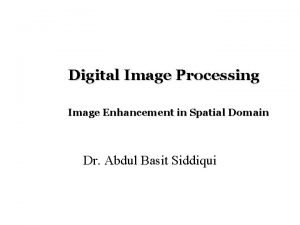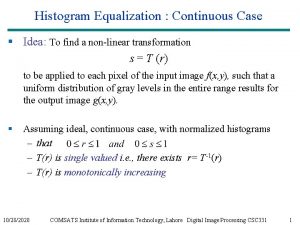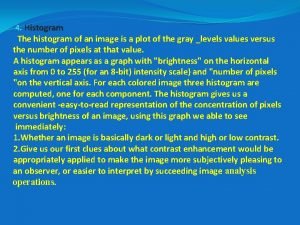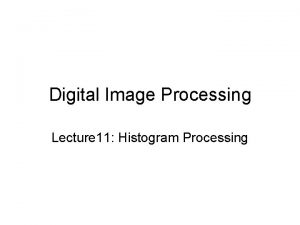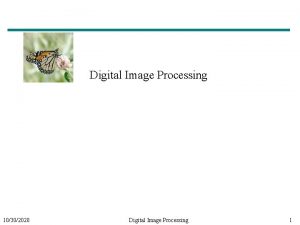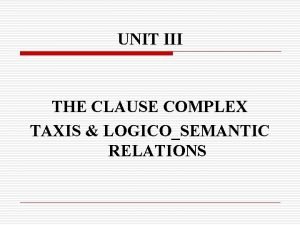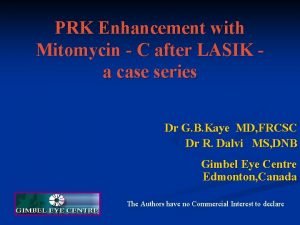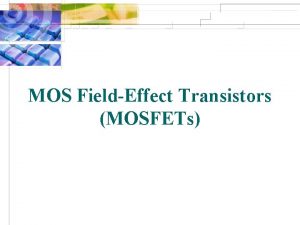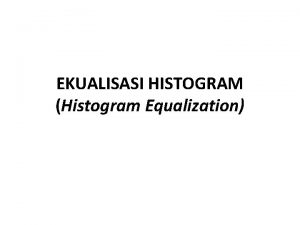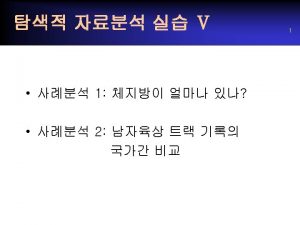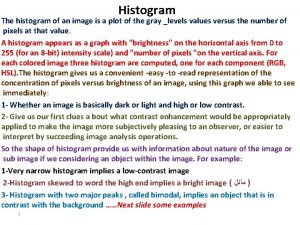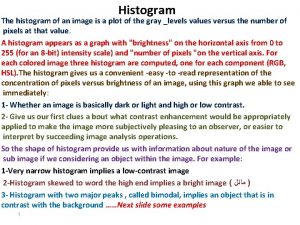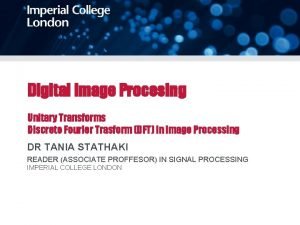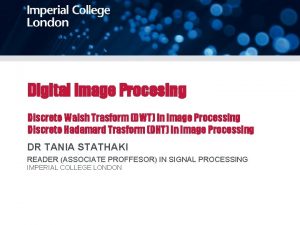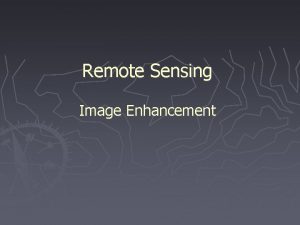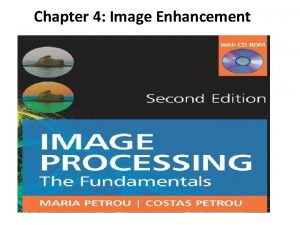Digital Image Procesing Introduction to Image Enhancement Histogram










































- Slides: 42

Digital Image Procesing Introduction to Image Enhancement Histogram Processing DR TANIA STATHAKI READER (ASSOCIATE PROFFESOR) IN SIGNAL PROCESSING IMPERIAL COLLEGE LONDON

Image Enhancement • The goal is to process an image so that the resulting image is: Ø more suitable than the original image for a specific application Ø of better quality in terms of some quantitative metric Ø visually better • Spatial domain methods • Frequency domain methods.

Spatial Domain Methods: Local neighborhood processing

Spatial Domain Methods: Point processing

Point Processing: contrast enhancement • In the figures below you can see examples of two different intensity transformations. • The figure on the right shows the process of binarization of the image.

Histogram Processing: definition of image histogram dark image bright image low contrast image high contrast image

Generic figures of histograms

Two different images with the same histogram.

Histogram Processing: definition of intensity transformation

Histogram Processing: definition of intensity transformation • The condition for T(r) to be monotonically increasing guarantees that ordering of the output intensity values will follow the ordering of the input intensity values (avoids reversal of intensities). • If T(r) is strictly monotonically increasing then the mapping from s back to r will be 1 -1. • The secondition (T(r) in [0, 1]) guarantees that the range of the output will be the same as the range of the input.

Monotonicity versus strict monotonicity a) We cannot perform inverse mapping (from s to r). b) Inverse mapping is possible.

Modelling intensities as continuous variables

Histogram Equalization: continuous form

Histogram Equalization: continuous form

Histogram Equalization: discrete form

A histogram equalization example in discrete form

A histogram equalization example in discrete form

A histogram equalization example in discrete form Notice that due to discretization, the resulting histogram will rarely be perfectly flat. However, it will more “extended” compared to the original histogram.

A set of images with same content but different histograms low contrast image dark image 1 bright image 2 4 3 high contrast image

Histogram equalization applied to the dark image 1

Histogram equalization applied to the bright image 2

Histogram equalization applied to the low and high contrast images 3 4

Transformation functions for histogram equalization for the previous example

An example of an unfortunate histogram equalization • Example of image of Phobos (Mars moon) and its histogram. • Histogram equalization (bottom of right image) does not always provide the desirable results.

Histogram Specification

Histogram Specification

Histogram Specification

Histogram Specification: Example original intensities number of probability pixels 0 790 0. 19 cumulative probability CM 0. 19 equalised normalised intensities equalised CM x 7 intensities 1. 33 1 1 1023 0. 25 0. 44 3. 08 3 2 850 0. 21 0. 65 4. 55 5 3 656 0. 16 0. 81 5. 67 6 4 329 0. 08 0. 89 6. 23 6 5 245 0. 06 0. 95 6. 65 7 6 122 0. 03 0. 98 6. 86 7 7 81 0. 02 1 7 7

Histogram Specification: Example desired probability intensities 0 1 2 3 4 5 6 7 0 0. 15 0. 2 0. 3 0. 2 0. 15 cumulative probability CM 0 0. 15 0. 35 0. 65 0. 85 1 equalised normalised intensities equalised CM x 7 intensities 0 0 0 1. 05 1 2. 45 2 4. 55 5 5. 95 6 7 7

Histogram Specification: Example original intensities 0 1 2 3 4 5 6 7 equalised intensities (AVAILABLE) 1 3 5 6 6 7 7 7 desired equalised intensities (NOT AVAILABLE!!!) intensities 0 1 2 3 4 5 6 7 0 0 0 1 2 5 6 7 equalised intensities (available) 1 3 5 6 6 7 7 7 NEW intensities (available) 3 4 5 6 6 7 7 7

Histogram Specification: Example Notice that due to discretization, the resulting histogram will rarely be exactly the same as the desired histogram. • • Top left: original pdf Top right: desired pdf Bottom left: desired CDF Bottom right: resulting pdf

Histogram Specification: Example • Specified histogram. • Transformation function and its inverse. • Resulting histogram.

Histogram Equalization: Examples

Histogram Equalization: Examples

Histogram Equalization: Examples

Histogram Equalization: Examples

Histogram Equalization: Examples

Histogram Equalization: Examples

Histogram Specification: Examples

Local Histogram Specification • The histogram processing methods discussed previously are global (transformation is based on the intensity distribution of the entire image). • This global approach is suitable for overall enhancement. • There are cases in which it is necessary to enhance details over small areas in an image. • The number of pixels in these areas may have negligible influence on the computation of a global transformation. • The solution is to devise transformation functions based on the intensity distribution in a neighbourhood around every pixel.

Local Histogram Specification: Examples

Local Histogram Specification: Examples
 Bottom up vs top down psychology
Bottom up vs top down psychology Top down vs bottom up processing
Top down vs bottom up processing Histogram processing in digital image processing
Histogram processing in digital image processing Digital foil enhancement
Digital foil enhancement Logarithmic transformation in image processing
Logarithmic transformation in image processing Image enhancement in night vision technology
Image enhancement in night vision technology Objective of image enhancement
Objective of image enhancement Image quality repair
Image quality repair Image enhancement by point processing
Image enhancement by point processing Spatial filtering
Spatial filtering Image enhancement in spatial domain
Image enhancement in spatial domain Image enhancement in spatial domain
Image enhancement in spatial domain Image enhancement in spatial domain
Image enhancement in spatial domain Image enhancement
Image enhancement Histogram equalization matlab
Histogram equalization matlab In a dark image the components of histogram
In a dark image the components of histogram Normalisasi histogram
Normalisasi histogram Histogram processing
Histogram processing In a dark image the components of histogram
In a dark image the components of histogram Introduction to digital image processing
Introduction to digital image processing Introduction to digital image processing with matlab
Introduction to digital image processing with matlab Image transform in digital image processing
Image transform in digital image processing Optimum notch filter in image processing
Optimum notch filter in image processing Spatial and temporal redundancy in digital image processing
Spatial and temporal redundancy in digital image processing Key stage in digital image processing
Key stage in digital image processing Analog image and digital image
Analog image and digital image Fidelity criteria in digital image processing
Fidelity criteria in digital image processing Image sharpening in digital image processing
Image sharpening in digital image processing Geometric transformation in digital image processing
Geometric transformation in digital image processing Fundamental steps in digital image processing
Fundamental steps in digital image processing Digital image processing
Digital image processing Image geometry in digital image processing
Image geometry in digital image processing Noise
Noise Complex sentence examples
Complex sentence examples Family enhancement center
Family enhancement center Mitomycin c prk
Mitomycin c prk Nmos inverter
Nmos inverter Mre
Mre Credit enhancement example
Credit enhancement example Coalition for physician enhancement
Coalition for physician enhancement Integrity enhancement features of sql
Integrity enhancement features of sql When applying monomer liquid and polymer powder
When applying monomer liquid and polymer powder Triode region current
Triode region current





